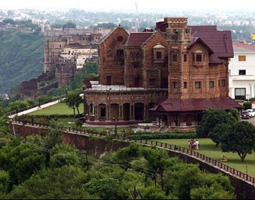
City Of Temples
Jammu also known as the City of Temples is nestled against the backdrop of the snowcapped Pir Panjal Mountains, the region of Jammu constitutes the southern most unit of the state of Jammu &Kashmir. Jammu is separated from Kasmir by Pir Panjal mountain range.Jammu borders Kashmir to the north, Ladakh to the east, and Himachal Pradesh and Punjab to the south. In the west, the Line of Control separates Jammu from the Pakistan region called Azad Jammu and Kashmir. Sandwiched between the Vale of Kashmir to the north and the Daman Koh Plains to the south, the Shivalik Range comprises most of the region of Jammu. The Pir Panjal Range, the Trikuta Hills and the low-lying Tawi River basin add beauty and diversity to the terrain of Jammu.The city of Jammu, the winter capital of the state, is the epicentre of all socio-economic activities in the Jammu region. It is also the base for visiting various centres of tourist and pilgrimage interest in which the region abounds.
Jammu is known for the cheapest textile products. Samba is famous for block printing and phoolkari embroidery.Paintings from Basholi which are based on vaisnavism are great buys.
Here the main bazaars Vir Marg, Raghunath Bazaar and Hari Market are famous for Kashmiri handicrafts, traditional Dogra jewellery and various dry fruits, chiefly walnuts (‘akhrot’) and almonds. Jammu is also known for the superlative quality of its ‘basmati’ rice, ‘rajma’ (red beans), ‘ampapar’ (dried and candied mango peel), ‘anardana’ (dried pomegranate seeds) and ‘barfi’ (milk sweets). For purchasing authentic Kashmiri handicrafts, one can visit the J&K Government Arts Emporium near the Tourist Reception Centre on Residency Road. The emporium displays and sells a wide variety of handicrafts, including Pashmina shawls and exquisite hand-knotted carpets of silk and wool.

We at Paradise and Beyond take immense pleasure in introducing ourselves as Registered Travel agents catering to tourism for the very beautiful state of JAMMU AND KASHMIR.Welcoming all the esteemed travel agencies and customers from all over India and abroad to use our safe, pleasant & reliable services.
Copyright © 2015 Echelon. All Rights Reserved | Design by Echelon